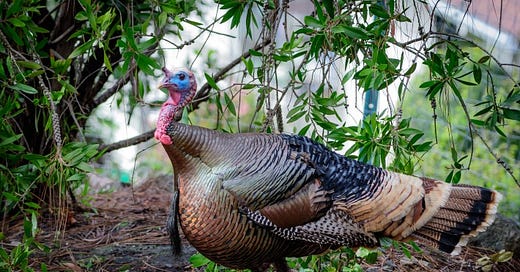This week's Bird of the Week might be familiar to some people, but that doesn't make it any less special. It's the one, the only, wild turkey.
Where to begin with this most wondrous of birds? Well, let's start with a picture.
It's easy to forget that turkeys are actually pretty glorious to look at. The rippling colors, the interplay of browns and creams and blacks and blues, all those feathers (an adult turkey has 5-6,000 of them) the sheer size of the things (it's one of the biggest birds in the Northern Hemisphere)—it all adds up to something wonderful. But this bird isn't just looks! There's a brain in there. As the Audubon Society reports, "Although the barnyard variety is a rather stupid creature (leading to the insulting tone of the term 'turkey'), the original wild form is a wary and magnificent bird."
Slightly insulting to domestic turkeys, but Bird of the Week is about stating the truth. The historical record also informs us that Ben Franklin wrote a letter to his daughter praising the turkey and disparaging the bald eagle as the national symbol of America. Personally, I'm glad we went with the eagle, because the turkey is already freighted with enough sociopolitical baggage without also handing it the burden of officially representing this place. And anyway, the wild turkey has meant something to a lot of people outside the United States. Take it away, The Spruce:
Wild turkeys, including the wild tom, with his bold tail fan, dangling snood, and bright wattles, were revered in ancient Aztec and Mayan civilizations. The Aztecs honored the wild turkey, which they called huexolotlin, with religious festivals twice a year and believed turkeys to be a bird manifestation of Tezcatlipoca, a trickster god. Because of that spiritual connection, the feathers of turkeys were frequently used to adorn necklaces, headdresses, jewelry, and clothing. The Mayans revered and honored turkeys in similar ways.
I sincerely love when a culture puts a bird on a pedestal. Imagine having not one but two religious festivals in your honor every year. That's living. Native Americans also played a key role in domesticating the turkey.
Naturally, of course, humans (read: white colonizing humans) nearly fucked everything up for the turkey, overhunting them and taking their land away to the point of near-extinction. Then people did something unheard of today, and actually fixed a problem, and now there are millions of wild turkeys around again. Look out on the road and you might see one!
OK some facts for you to "gobble" up, yes I am that corny, also some videos!
Turkeys can fly up to 50 miles per hour, and they can also swim. They can also run very fast and they have great eyesight. Here are some turkeys flying (I chose this video because the person filming it goes "what's up turkeys" and I liked that):
And here's a video of a turkey swimming in a lake ("turkeys do swim in lakes," the videographer says, which, yes, clearly, I am watching it do that):
They gobble but they also cluck and purr:
They are big on community. From the Dodo:
Turkeys need each other, and in more than just a safety-in-numbers sort of way. Researchers have found that when an individual turkey is removed from his flock, even in domesticity, he'll squawk in obvious protest until reunited with his posse. Turkeys have a refined "language" of yelps and cackles. They mourn the death of a flock member and so acutely anticipate pain that domestic breeds have had epidemical heart attacks after watching their feathered mates take that fatal step towards Thanksgiving dinner. They clearly feel and appear to understand pain.
Yikes on the last one. Eating meat is...morally complicated. Here's my favorite example of a turkey flock. This one keeps terrorizing some New Jersey residents with its flockiness:
And, finally, the turkey is another one to add to our list of birds against the police. Check this out:
Turkey 1, disgusting stupid cop 0. All hail the turkey!
A reminder: you can check out our complete Bird of the Week list here, and get in touch with your bird suggestions at hello@discourseblog.com.






